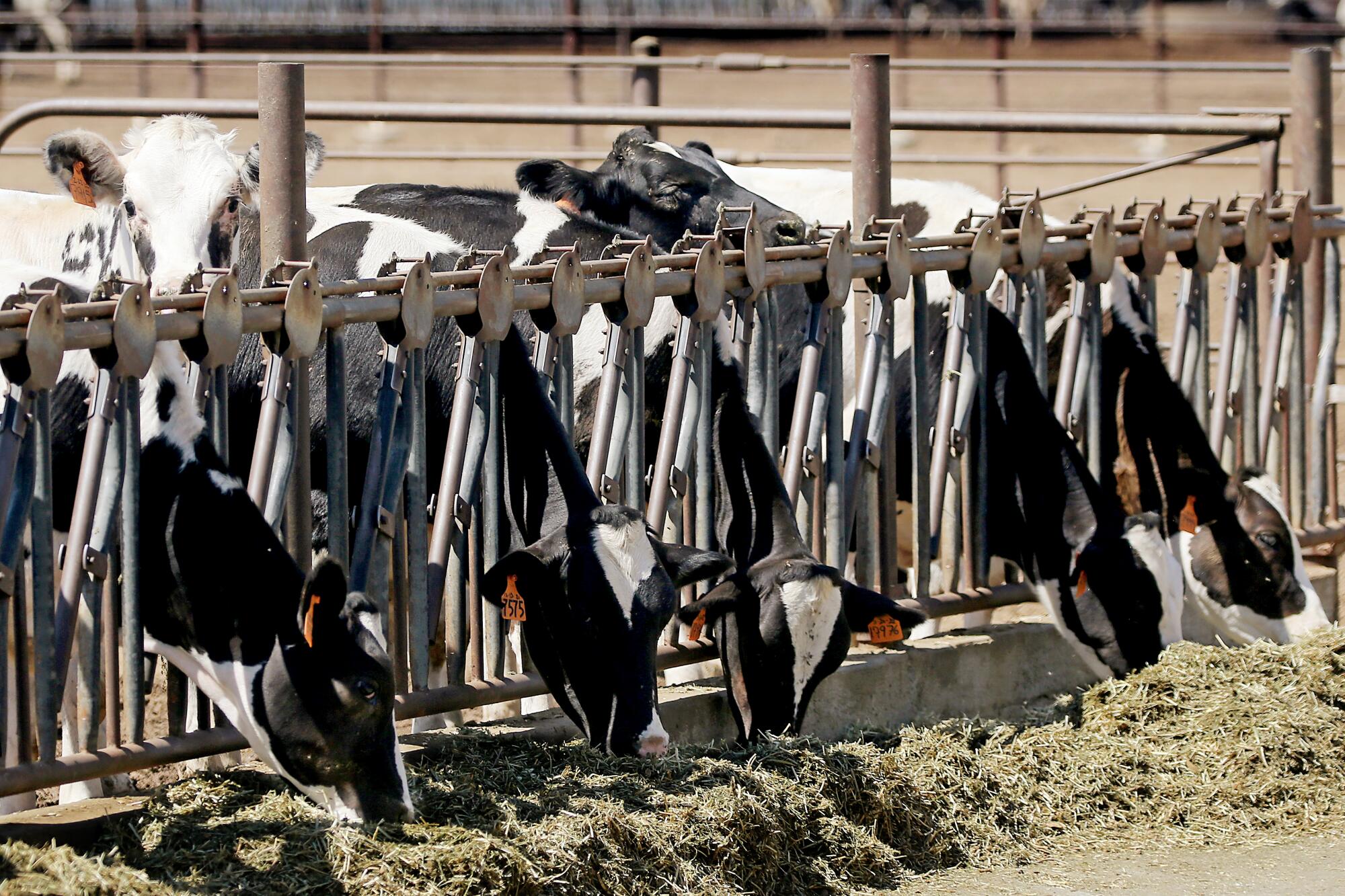
- Share via
- 93 California dairy herds have tested positive for the H5N1 virus as of Oct. 9.
- California has roughly 1,100 herds and 1.7 million cows. It accounts for 20% of the milk produced in the country.
As a rapidly increasing number of California dairy farms suffer outbreaks of H5N1 bird flu, industry experts say it remains unclear just how the disease may affect the nation’s milk supply or pricing.
As of Oct. 9, the nation’s largest milk producing state had reported 93 H5N1 outbreaks in dairy herds — nearly doubling in the span of a week.
There have also been three confirmed and two presumptive cases of human infection. All five cases were among Central Valley dairy workers who had no known connection.
State and federal health authorities insist that H5N1 poses little threat to humans and that it is safe to drink milk that has been pasteurized, because the process kills the virus.
However, dairy farmers and veterinarians are reporting far greater rates of mortality among infected herds than anticipated and steep drops in the rate of milk production among recovered cows. At the same time, some epidemiologists fear that as the virus spreads among California farms, it greatly increases the odds that it can mix with a human virus and create a health threat for people.
Although California dairy farmers anticipated a bird flu mortality rate of less than 2%, some say between 10% and 15% of infected cattle are dying.
Although the number of outbreaks has had little impact on overall milk production, some experts warn that the number of infected farms could grow substantially in the coming weeks.
“Things are going to get worse before they get better,” said Michael Payne, a researcher and outreach coordinator at the Western Institute for Food Safety and Security at UC Davis.
What this means for the nation’s milk supply — and milk prices — remains unclear.
“So far, there has been little industrywide impact of the disease on share of cattle affected in California, so little impact on marketable dairy production,” said Daniel Sumner, an agricultural economist at UC Davis. “There is almost no bird flu on dairies outside California, and that means farm milk prices have not risen measurably.”
He said that unless many more herds are affected in California or elsewhere, “farm milk prices and consumer milk prices are unlikely to rise measurably.”
Nathaniel Donnay, director of dairy market insight with StoneX, a financial services company, agreed that production impacts have been relatively small; however, “It only takes small changes in supply or demand to have a big impact on prices.”
He said looking at the extent of the reported outbreak, about 4.8% of the nation’s dairy cows have been infected. However, the actual number may be “much higher since many cases have gone unreported.”
The drop in milk production for an individual cow or farm can be quite large — recent reports from California show that an infected cow can lose up to 100% over a few days, and later return to 60% to 70% of typical production. Elsewhere, that number has been closer to 5% to 10%. However, when compared with national milk production, or production in individual states, the impact is much smaller, Donnay said.
For example, U.S. Department of Agriculture data for heavily affected states such as Texas, Idaho and Colorado showed a 1% to 3% drop in year-over-year milk production.
In Colorado, where 60% of the farms suffered outbreaks, milk production by cow dropped only 2.6% since last June, Donnay said.
H5N1 in dairy cattle has been “knocking 0.2% to 0.5% off U.S. level milk production since March, and the spread into California could knock something closer to 0.5% to 0.8% off U.S. milk production for October,” Donnay said.
“Either way, it is a relatively small impact,” he said.
As the range and incidence of valley fever grows, public health officials are struggling to warn visitors of the risk.
In order for there to be a significant impact on national milk production, Donnay said that 500 or more herds would have to be infected in a month.
California has roughly 1,100 herds and 1.7 million cows and produces 20% of the milk produced in the country.
Fortunately for dairy farms across the nation, milk prices are high, and feed costs are down, Donnay said. That means profitability margins for the nation’s dairy farmers are looking “very, very good” — even with the raging viral outbreak.
Of bigger concern is the outstanding question of whether infected cows will rebound in their next lactation cycle — after they’ve had time to “dry out” and heal.
According to Payne, at UC Davis, a typical dairy cow milks for about nine months. Milk production is initially stimulated by the birth of a calf. It ramps up in the weeks after birth — peaking between weeks six and 10 — and slowly tapers off over the next several months.
While the cow is milking, she is impregnated. Roughly two months before she is to give birth again, she is taken out of the milking barn and “dried out.” Then, after she’s given birth again, she’s put back into the mix.
The first cows infected in Texas are only just now reentering the mix, and it’s still too early to tell whether those first infected cows will come back to pre-infection production, or stay depressed, Payne said.
Donnay said statewide milk production is variable across time, but looking at the 14 states that have had bird flu, there are clear signatures in the data: a marked drop in production that lasts for a few weeks.
He said it is clear — from data and his conversations with farmers — that there has been vast under counting of the disease in the nation’s dairy herds.
He said the explosion being seen in California is partly the result of rapaciousness of the virus, but also an artifact of the state’s efforts to test every herd within 6 miles of an infected herd, as well as any herd that has an epidemiological tie with one that’s been infected — shared personnel, equipment or veterinarians, for example.
He said Colorado was the only other state that exploded in the same way that California has — and again, the high numbers were likely the result of mandated testing.
He said when testing was finished in Colorado, somewhere between 60 and 100% of the state’s herds had been infected.
If the same can be expected for California, he said, the state could be looking northward of 600 cases in the next few weeks.
John Korslund, a retired U.S. Department of Agriculture veterinarian epidemiologist, said if that were to happen — and he said he has reason to believe it will — “I would estimate that the California dairy outbreak is the most serious and widespread infectious animal disease outbreak in history.”











